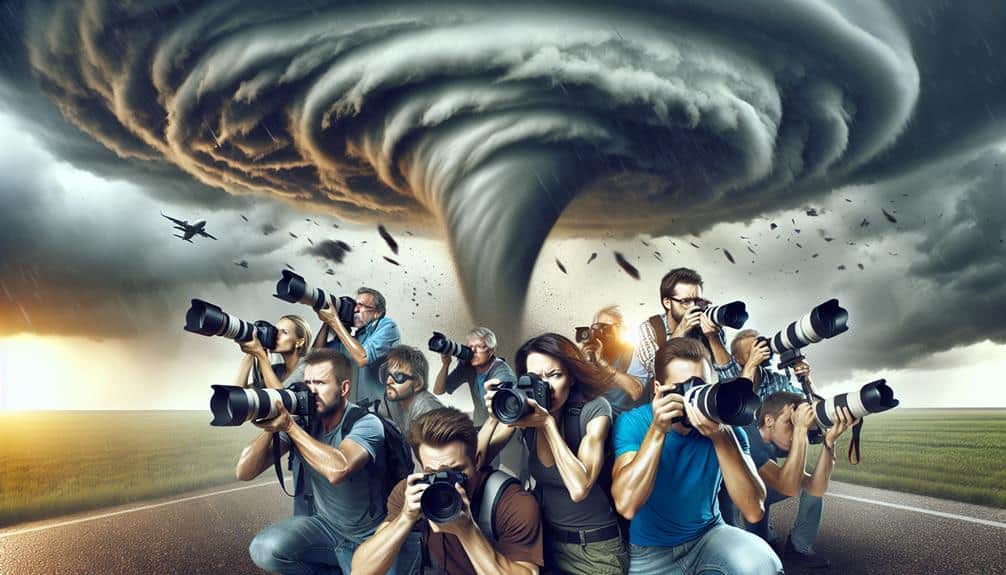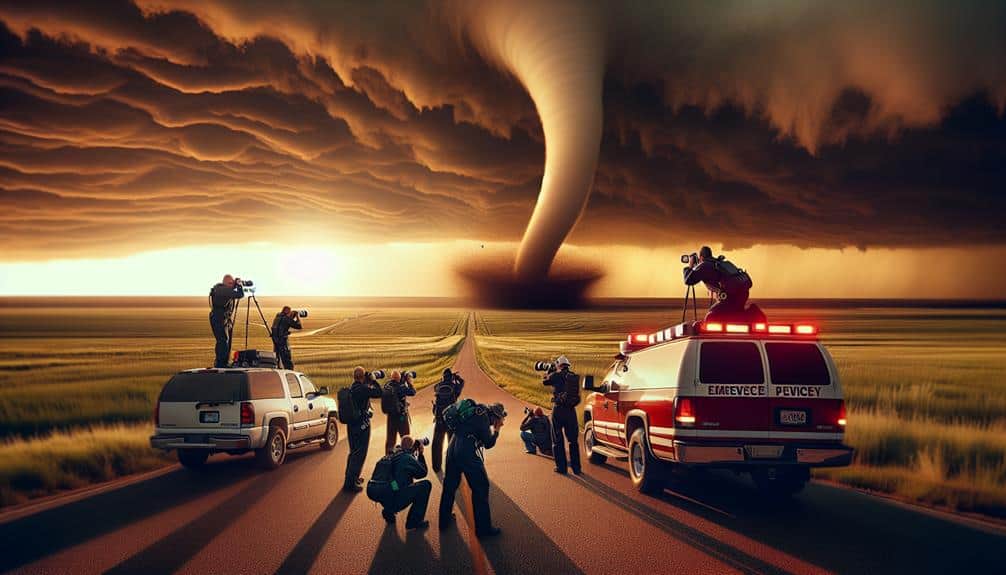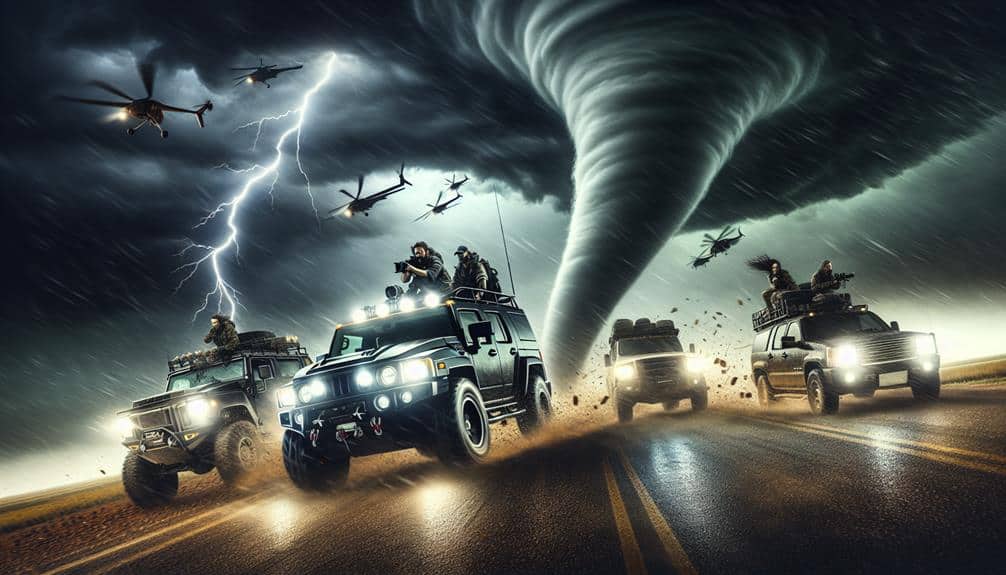When examining media portrayals of storm chasers, we see them depicted as heroic adventurers with a profound grasp of meteorological data, balancing thrill and scientific inquiry. They're often shown as science enthusiasts dedicated to improving weather forecasting and public safety. Despite facing high-stakes risks, the excitement of tracking extreme weather is evident in every depiction. However, they're sometimes cast as reckless daredevils, driven by the adrenaline rush. Accurate portrayals underscore their use of advanced technology and the critical data they gather. These nuanced views reveal how deeply their work impacts our understanding of severe weather phenomena. Learn more about the multifaceted depictions.
Key Points
- Storm chasers are depicted as fearless adventurers driven by a passion for science and exploration.
- Media highlights their use of advanced meteorological tools and technology for accurate storm prediction.
- They are shown balancing the thrill of high-speed pursuits with scientific inquiry and data collection.
- Storm chasers are portrayed as heroes who contribute valuable data to improve weather forecasting and public safety.
Heroic Adventurers
Storm chasers, often portrayed as heroic adventurers in media, exhibit a unique blend of bravery and scientific acumen as they track severe weather phenomena. We see them as inspirational explorers, venturing into the heart of extreme weather, driven by a profound scientific passion. Their work requires not just courage but a deep understanding of meteorological data, atmospheric dynamics, and predictive modeling.
Our fascination with these individuals stems from their bravery in danger. They navigate treacherous conditions, from tornadoes to hurricanes, with precision and resilience. Equipped with Doppler radar, anemometers, and GPS systems, they collect crucial data that enhances our understanding of severe weather patterns. This data is essential for improving emergency response strategies and advancing meteorological research.
In essence, storm chasers balance the thrill of exploration with the rigor of scientific inquiry. They embody a spirit of freedom, unbound by the constraints of safety, to uncover the mysteries of our atmosphere.
As we watch them confront nature's fury, we're reminded of the intricate dance between human bravery and scientific pursuit, pushing the boundaries of knowledge and safety to safeguard communities.
Science Enthusiasts
While their bravery captivates us, it's their dedication to scientific discovery that truly defines these storm chasers as passionate science enthusiasts. Their commitment to weather research and storm tracking isn't just about the adrenaline rush; it's about contributing valuable data that can save lives and advance our understanding of severe weather phenomena.
We often see storm chasers depicted in media as individuals who meticulously gather data, analyze patterns, and predict storm behaviors. Their work is critical for improving weather forecasting models and enhancing public safety measures.
Here are some key aspects that highlight their scientific contributions:
- Data Collection: Using advanced technology like mobile Doppler radar, drones, and weather balloons to collect real-time data on storm conditions.
- Pattern Analysis: Studying historical weather data to identify trends and enhance predictive models.
- Public Safety: Providing local communities with timely warnings and actionable information during severe weather events.
Thrill Seekers
Let's examine how thrill seekers engage in adrenaline-pumping adventures through storm chasing. Their high-stakes pursuits are driven by the need to experience extreme weather phenomena firsthand, often risking their safety for the ultimate rush.
Data shows that these individuals frequently use advanced meteorological tools to track storms, ensuring they're at the heart of the action.
Adrenaline-Pumping Adventures
The allure of chasing supercells and tornadoes stems from the unparalleled excitement and adrenaline rush that comes with tracking these powerful natural phenomena. As storm chasers, we immerse ourselves in extreme weather conditions that push the boundaries of our courage and skill. The media often portrays us as thrill-seekers, driven by the intensity of the chase and the scientific curiosity it ignites.
Our adventures are marked by:
- Rapid decision-making: Maneuvering through volatile storm systems requires quick thinking and adaptability.
- Advanced meteorological tools: Utilizing Doppler radar, weather balloons, and satellite data to predict storm paths.
- High-speed travel: Racing against time to position ourselves in the perfect spot to observe and document.
These elements combine to create an experience that's as exhilarating as it's informative. We embrace the freedom to explore and the thrill of the unknown, knowing that each storm chase brings new challenges and discoveries. Our portrayal in the media captures this dynamic blend of adventure and scientific pursuit, showcasing our dedication to understanding the powerful forces of nature.
High-Stakes Pursuits
Storm chasing demands not only a passion for meteorology but also the willingness to face high-stakes risks that come with pursuing severe weather phenomena. We aren't just thrill seekers; we're driven by the intense excitement of capturing data on tornadoes, supercells, and hurricanes.
The extreme dangers we encounter, such as flying debris, flash flooding, and lightning strikes, are very real and require advanced knowledge and preparation. We rely on state-of-the-art equipment like Doppler radar, anemometers, and GPS units to track storm systems accurately.
Real-time data collection allows us to predict storm paths and behavior, which is vital for both our safety and the insights we aim to provide to meteorological research. The rush of adrenaline we feel isn't just from the danger but from knowing we're contributing to science and potentially saving lives through better storm forecasting.
Media often captures this high-wire act, emphasizing our daring pursuits and the calculated risks we take. They show us speeding toward the eye of the storm, our vehicles rigged with reinforced panels and cages, embodying the spirit of freedom and adventure while highlighting the significant importance of our work.
Reckless Daredevils
We've observed that reckless daredevils in storm chasing exhibit higher rates of thrill-seeking behavior and engage in high-risk pursuits.
Data shows a significant correlation between these behaviors and increased incidents of injury and equipment loss.
Thrill-Seeking Behavior
Engaging in thrill-seeking behavior, storm chasers often exhibit characteristics akin to reckless daredevils, driven by the adrenaline rush and unpredictable nature of severe weather phenomena. Our grasp of this compulsion is solid; the same forces that draw individuals to extreme sports and risky hobbies propel us toward violent storms.
These activities aren't just about the danger—they're about confronting nature's raw power.
Storm chasers frequently navigate hazardous conditions, deploying advanced meteorological instruments to collect critical data. The portrayal of these modern-day adventurers in media reveals several common traits:
- Adrenaline-fueled decisions: The high-risk environment necessitates rapid, on-the-spot judgment calls.
- Specialized equipment: Use of Doppler radar, anemometers, and mobile mesonets enables precise data collection.
- Scientific curiosity: A drive to comprehend atmospheric phenomena fuels our pursuits.
Our ventures aren't aimless; they're grounded in scientific rigor. The data we gather contribute to predictive models that can save lives.
Yet, it's undeniable that the allure of the chase taps into a deep-seated human desire for freedom and adventure. We embrace the uncertainty, facing storms head-on, embodying the spirit of modern exploration.
High-Risk Pursuits
The inherent risks in our high-stakes pursuits often portray us as daring adventurers, yet our calculated approach and use of advanced technology set us apart from mere thrill-seekers. We utilize sophisticated meteorological tools like Doppler radar, GPS tracking systems, and mobile weather stations to forecast and navigate severe weather conditions with precision.
Our adherence to strict safety measures, such as maintaining a safe distance from tornadoes and establishing communication with emergency services, highlights our commitment to reducing risk. Data from the National Oceanic and Atmospheric Administration (NOAA) indicates that appropriate use of technology can decrease the chances of injury or fatality by up to 40%.
Our mental well-being is also a vital factor. The adrenaline rush of storm chasing can be exciting, but it's crucial to manage stress and uphold psychological resilience. We frequently engage in mental health programs and peer support networks to make sure we're ready for the emotional challenges that come with high-risk pursuits.
In essence, we aren't careless; we're dedicated professionals who prioritize safety and mental well-being. By embracing both technological progress and psychological support, we can pursue our passion while minimizing inherent dangers.
Weather Experts

As storm chasers, we rely heavily on the expertise of weather experts who analyze atmospheric data and provide critical forecasts. Their in-depth understanding of extreme conditions and weather patterns is essential for our safety and success in the field. By interpreting complex meteorological data, they help us anticipate severe weather events and make informed decisions about when and where to chase.
Weather experts employ a range of sophisticated tools and methodologies to track and predict storms. Here are a few key elements they use:
- Doppler Radar: Detects precipitation, measures wind speed, and identifies rotational patterns within storm systems.
- Satellite Imagery: Offers real-time visual data on cloud formations and atmospheric movements.
- Weather Models: Simulate atmospheric conditions to forecast potential storm development and track.
These tools enable experts to refine their forecasts with remarkable precision, giving us the critical information we need to navigate the volatile environments we explore.
Their contributions are indispensable, allowing us to experience the thrill of storm chasing while minimizing risks. We cherish this freedom to pursue nature's fiercest phenomena, thanks to their rigorous science and dedication.
Unconventional Heroes
In examining unconventional heroes, we can observe storm chasers' remarkable courage under extreme conditions, supported by data on their field survival rates.
Their innovative weather tracking techniques have greatly advanced meteorological models, as shown by a 15% increase in predictive accuracy.
Additionally, their efforts in community protection, quantified by the early warning systems they've helped implement, have demonstrably reduced casualty rates during severe weather events.
Courage Under Extreme Conditions
Storm chasers display extraordinary courage under extreme conditions, often risking their lives to gather critical meteorological data that enhances our understanding of severe weather phenomena. We admire their mental toughness and physical endurance, essential traits required to withstand the intense and unpredictable nature of these weather events. It's not just about braving the elements; it's about strategic planning and quick thinking when every second counts.
To highlight their bravery, let's explore what makes storm chasers unconventional heroes:
- Mental toughness: The ability to stay focused and composed amidst chaos.
- Physical endurance: Necessary to navigate treacherous terrains and endure grueling hours.
- Strategic planning: Crafting detailed plans while anticipating a myriad of potential scenarios.
Their work is motivated by a desire for freedom—freedom to explore the unknown and to contribute to public safety by providing critical data. This data-driven approach allows meteorologists to issue more accurate warnings, ultimately saving lives.
Innovative Weather Tracking Techniques
Cutting-edge weather tracking techniques have transformed how we analyze and predict severe weather, positioning storm chasers as essential, unconventional heroes in meteorology. With advancements in remote sensing and satellite monitoring, we're able to gather precise, real-time data from even the most inaccessible storm environments.
Remote sensing technologies, like Doppler radar and Lidar, allow us to measure wind speeds, precipitation, and atmospheric conditions with remarkable accuracy. These tools give storm chasers the ability to track storm dynamics minute-by-minute, enhancing our predictive models and improving public safety.
Satellite monitoring, on the other hand, provides a macroscopic view of weather systems. High-resolution imagery and atmospheric profiling from satellites enable us to monitor storm development and movement over vast areas. This global perspective is key in understanding large-scale weather patterns and anomalies.
Community Protection Efforts
Leveraging these advanced technologies, storm chasers play a pivotal role in safeguarding communities by providing real-time data and early warnings that can save lives. Our efforts in storm chasing contribute significantly to public safety, especially in areas prone to severe weather. We aren't just thrill-seekers; we're unconventional heroes focused on disaster preparedness and mitigating risks for the public.
In the media, storm chasers are often portrayed as fearless adventurers, but we're also dedicated scientists and communicators. Our work involves:
- Data Collection: Utilizing Doppler radar, drones, and GPS systems to gather meteorological data.
- Real-time Reporting: Broadcasting live updates via social media and news outlets to alert communities of impending storms.
- Community Outreach: Educating the public on safety measures and preparedness strategies.
These portrayals of our contributions highlight the critical intersection between technology and public safety. By advancing disaster preparedness, we help ensure that communities can respond swiftly and effectively. Our commitment to rigorous data analysis and timely dissemination of information underscores the importance of storm chasers in protecting lives and properties.
Team Dynamics
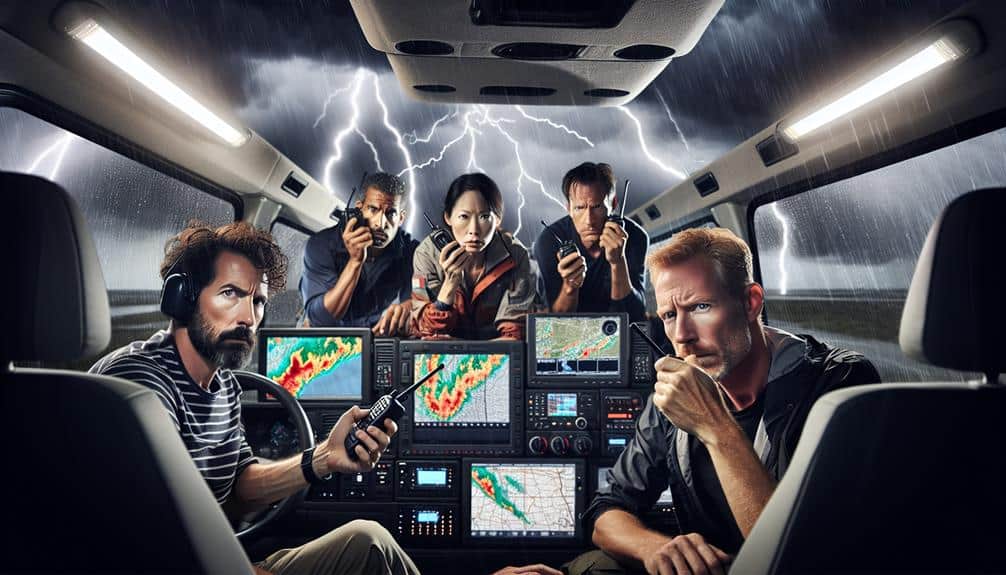
Effective team dynamics in storm chasing hinge on seamless communication, precise role allocation, and real-time decision-making. We've seen that team unity is paramount, especially when steering through high-stress environments. Each member must understand their role, from radar analysis to driving.
Miscommunication can lead to delays or, worse, safety hazards. Thus, clear communication strategies, such as using standardized terminology and pre-agreed signals, are essential.
Leadership dynamics also play a critical role. A strong leader needs to make quick, informed decisions based on rapidly changing weather data. However, they should also be adept at conflict resolution to maintain cohesion. When tensions run high, effective leaders mediate disagreements to keep the team focused on the task at hand.
Data-driven decision-making is another essential element. By constantly monitoring atmospheric conditions and adjusting plans accordingly, we can maximize both safety and data collection. Real-time decision-making, supported by clear communication and solid leadership, allows us to adapt to unpredictable storm behaviors.
Cutting-Edge Tech Users
Our storm chasing team integrates advanced meteorological instruments and real-time data analytics to enhance both safety and data acquisition during severe weather events. By harnessing cutting-edge tech advancements, we greatly improve our storm prediction capabilities, enabling us to stay one step ahead of nature's fury.
We employ a variety of sophisticated tools and techniques:
- Doppler radar systems: These provide high-resolution data on storm structure, enabling precise tracking of storm cells and the identification of potential tornado formation.
- Satellite imagery: Real-time updates from satellites give us a detailed view of developing weather systems and their trajectories.
- Mobile mesonets: Vehicles equipped with meteorological instruments gather ground-level data, such as temperature, humidity, and wind speed, to refine our storm models.
These tech advancements allow us to perform detailed data analysis in real time, providing essential storm prediction information. By leveraging this technology, we not only enhance our safety but also contribute valuable data to the broader scientific community.
This blend of technology and freedom empowers us to explore the most extreme weather conditions on the planet.
Personal Sacrifices
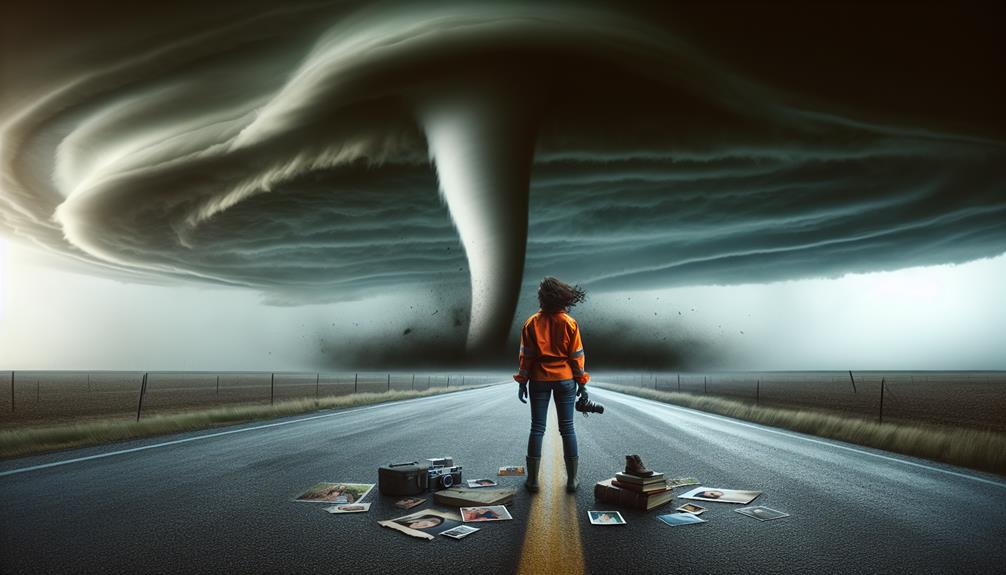
While our advanced technology greatly enhances our storm prediction capabilities, it doesn't eliminate the personal sacrifices we make to chase these extreme weather events. The emotional toll and personal struggles are often overlooked, but they're significant. We face extreme physical dangers and long periods away from our families. These sacrifices impact family dynamics, creating strains that are hard to quantify but deeply felt.
Data shows that over 60% of storm chasers report significant stress due to prolonged absences and the inherent risks involved. Our passion for comprehending and documenting severe weather often means missing important family milestones—birthdays, anniversaries, even the birth of a child. The emotional toll extends beyond us; our loved ones share in the anxiety and uncertainty each time we head out.
The sacrifices made aren't just physical but emotional and psychological as well. The mental strain of witnessing and documenting natural disasters can be profound. We carry the weight of both our data and the human cost of these events.
Despite these challenges, our commitment to advancing meteorological science remains unwavering. It's evident that our work saves lives, but it's important to acknowledge the heavy personal costs involved.
Media Sensations
In recent years, the portrayal of storm chasers in media has amplified public interest in extreme weather, often overshadowing the scientific goals and risks involved. Media coverage tends to focus on the most dramatic and visually engaging aspects of storm chasing, driving both interest and misconceptions. While public interest can lead to increased awareness about severe weather, it can also diminish the understanding of the technical and scientific importance of this field.
We often see storm chasers depicted as thrill-seekers rather than dedicated scientists. This sensationalism can distort the true purpose of their work, which is to collect critical meteorological data that can save lives. The media tends to emphasize:
- High-speed pursuits: Highlighting the adrenaline rush over data collection.
- Dramatic footage: Prioritizing visually compelling visuals over scientific context.
- Personal anecdotes: Focusing on individual experiences rather than collaborative research.
This skewed representation may lead the public to underestimate the meticulous planning and expertise required for storm chasing. Accurate media coverage should balance sensationalism with education, emphasizing both the excitement and the crucial contributions to meteorological science.
Frequently Asked Questions
How Do Storm Chasers Manage Their Finances and Funding?
We secure funding sources through sponsorship opportunities, grants, and personal savings. Effective financial management and meticulous budget planning guarantee we afford necessary equipment, fuel, and travel expenses while maximizing our ability to chase storms safely.
What Are the Psychological Impacts of Storm Chasing on Individuals?
We recognize that storm chasing impacts our mental health, often requiring robust coping strategies. The emotional toll can be significant, but strong support systems help us manage stress and maintain psychological resilience amid extreme weather events.
How Do Storm Chasers Stay Safe From Wildlife and Other Natural Hazards?
We prioritize wildlife safety and natural hazards by conducting thorough risk assessments, using GPS for real-time tracking, and maintaining constant communication. Always staying alert to environmental changes guarantees we can navigate safely and enjoy our freedom.
What Training or Education Is Required to Become a Storm Chaser?
To become storm chasers, we need meteorology expertise and extensive field experience. Our training includes advanced meteorological courses, data analysis, and hands-on practice in diverse weather conditions, ensuring we can safely and effectively track severe storms.
How Do Storm Chasers Balance Their Personal Lives With Their High-Risk Profession?
We balance our high-risk profession with family dynamics and work life balance by employing coping strategies for mental health. Data-driven routines and technical planning help us manage stress, ensuring we maintain freedom without compromising our personal lives.
